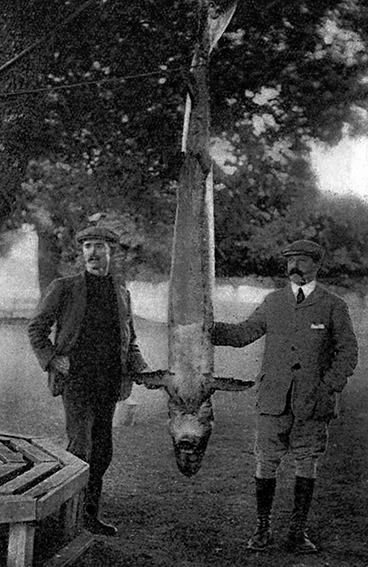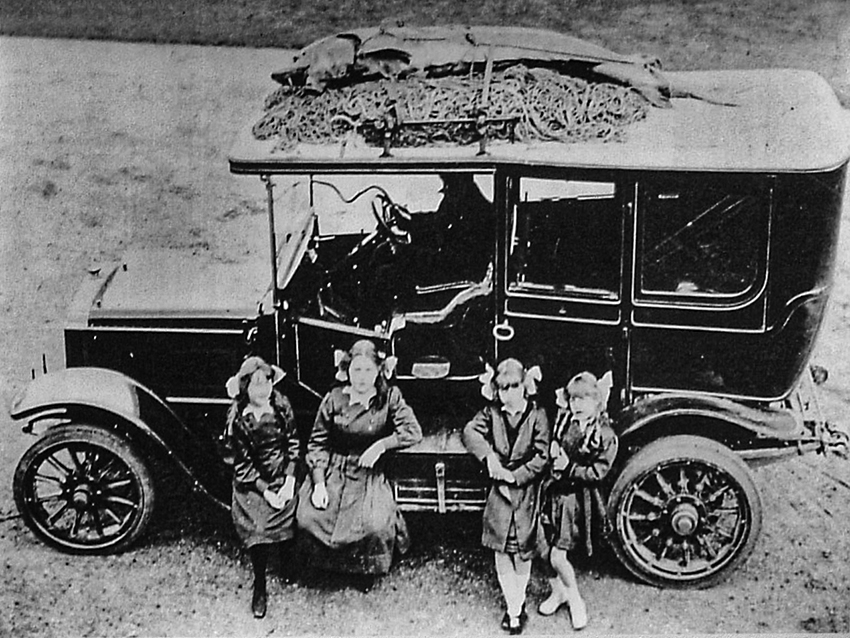Collection Blog
A Fisherman’s Tale: The Monster Fish of the River Frome
July 2, 2023
Visitors to the Dorset Museum may have noticed the large fish suspended in the Natural Dorset exhibit in the Lulworth Gallery.
Believe it or not, this is a European sturgeon (Acipenser sturio), is one of the largest fish ever to be caught in an English river using a fishing rod. Nearly three metres in length and weighing 92 kilograms, this fish was caught by Major Charles Robert Eustace Radclyffe of Hyde House, Bere Regis in the River Frome at Bindon Mill on 2nd July 1911.

Here is his amusing fisherman’s tale taken from the Dorset Year Book 1918 -1919 from Major C.E. Radclyffe’s article ‘My Years of Sport in Dorset’:
“And now we tune to the gentle art, so well beloved by Issac Walton. Here again in Dorset rich in rewards for those who frequent the banks of her silvery streams. True it is that the River Stour is not so noted for its pellucid waters as for the size of the great course fish which frequent its dark and deep pools. But in the clear waters of those beautiful streams, the Frome and the Piddle, which teem with all kinds of fish from salmon and trout to grayling pike, roach and dace, an angler must be hard to please if he cannot there find anything to amuse him. No two men beautiful streams are to be found in England than these which meander over their winding courses and glide gently into Poole Harbour by two months situated a short distance apart.
The Frome in its upper reaches yields magnificent trout fishing, whilst in its lower stretches salmon run up to 50 lbs. in weight, and enormous pike and countless coarse fish, and a few sea trout, frequent its waters. The Piddle is, without doubt, one of the best trout streams in England, and teems with fish for many miles.
Born and bred on the finest stretch of the latter river, it is not to be wondered at that in early youth I took fishing as a duck takes to waters to their mouths, which I have not explored and fished in the past 35 years, and during that time have taken from them many hundreds of fine trout, and many scores of salmon.
An angler is always expected to have some great yarn to tell of each river he has fished, and the writer does not plead to be an exception to this rule; in fact, he could fill a book of yarns on Dorset angling. The difficulty is to get people to believe them all. But the following is a well-authenticated event which happened seven years ago.
Early in the season, I was fishing the lower waters of the Frome for salmon with a friend. Shortly after we had started, my friend came running wildly towards me across the meadows, as if chased by a mad bull. Breathlessly he explained that he had seen the biggest salmon in the world I reasoned with him that even a 40-pound salmon looked ‘some fish’ in a small river like the Frome. Whereupon he swore solemnly that this fish was at least 140 lbs. As the old saying goes ‘seeing is believing’, so we went to the spot, and soon in the centre of the pool appeared a huge back fin shaped like that of a shark. A closer inspection showed the back of an enormous fish, which my friend had clearly underestimated at 140 lbs. But this great back with scales like armour plating was familiar to me, since I had killed sturgeon in Russia, and hence was able to say at once that my friend is a sturgeon, and a big one; but how to land him on our light tackle is more than I can say. Repeatedly the monster rolled on top of the water close between our feet, and finally, we decided to borrow a gun from a neighbouring farm and shoot the fish.
The gun having arrived we waited until the fish again showed on top of the water, and then gave him both barrels in the head at a distance of five yards. The only result was to make him take a series of wild rushes across the stream, where he began to roll about as before, apparently none the worse for a double dose of No. 5 shot. Seeing that big things required strong measures, I sent my car home for an elephant rifle, and we waited. Just before the rifle arrived the fish disappeared in a deep pool, and although we patrolled the river, and had scouts out looking for him for days afterwards, we did not then find further traces of the fish and decided he must have returned to the sea.
Two months later, a man arrived from Bindon Abbey with a request that I would go the next morning to try and catch the biggest salmon in the world, which was then in a big weir pool. From the man’s description, I had no difficulty in deciding that here was our long-lost sturgeon.
Early next morning, armed with the strongest rod and line I possessed, and have rigged up a grappling tackle of the largest-sized salmon flies, a party of five of us stood watching the weir pool. After an hour’s waiting, there suddenly appeared the great shark-like fin, and then the back of our friend the sturgeon.
Since a sturgeon belongs to the family of bottom-feeding fish, it was obviously impossible to hook this one with any form of bait. Hence it became a problem of casting over the monster and trying to get the hooks to grapple in some soft spot. This was by no means easy owing to the thickness of its skin and armour-plated scales. Finally, however, I grappled the fish under the jaw, and then the fun began. For one hour and forty-five minutes, I and a friend took turns at the rod, as the continuous strain on one’s arms was more than one man could stand for long; and at last, it felt like trying to hold or turn a motor car with a rod and line.
As a last resource we had to requisition services of a small seine net, and floating it downstream until the fish struck into it. The fish tangled itself up like a fly in a spider’s web and was thus hauled into shallow water. It took three men with two gaffs to land this leviathan, which measured no less than 9 feet 3 inches from nose to tail; verily the largest fish ever captured with rod and line in an English river.

According to a time-honoured custom, I presented the fish to His Majesty King George, who graciously returned it to me with a request that it might be preserved in my private museum at Dorchester; all of which was done in due course.
An amusing incident occurred as the fish was landed. A local labourer arrived with a towel on his shoulder for a morning bathe. On seeing the fish he said, ‘Lord, zur, do ee think there’s another of they girt brutes about, cause if ‘tis I bain’t agoin’ to bathe in thik pool agean,’ and I don’t believe he has done so since then.
I have often heard a fine fisherman say he considers the Frome to be the most sporting, and best all-round river in England. And although I can claim a somewhat unique record of having caught salmon in almost every country in the world where they are known to exist, from Iceland Scandinavia and Russia to Siberia, Kamchatka, Japan and Alaska; and from British Columbia to Newfoundland; yet I look back with great pleasure of all to the days on which I have landed my first and many subsequent great salmon, on the banks of the dear old Frome.
“Big things with fins’
Sturgeon are rare visitors to our rivers. They have four barbels which are tactile organs in front of their toothless mouth that seek out food on murky river bottoms. Sturgeon are covered with bony plates called scutes rather than scales; the Victorians made jewellery out of these, setting them in silver and gold.
Most species of Sturgeon are highly prized for their caviar and, as they are slow growing and mature very late in life, are consequently at risk of extinction, as a result of over fishing, poaching, black market trading, and habitat loss. Caviar comes from the Persian word Khaviar which means ‘bearing eggs’ and can cost several hundred pounds for a small pot. Now the Sturgeon is protected and can no longer be caught for its caviar.
It has been suggested that sturgeon may have been the origin of some sightings of the Loch Ness Monster.
In Morris Collman’s book ‘Hants and Dorset’s Legends & Folklore’, published by James Pike Ltd, 1975. He mentions a local Dorchester tradition that monster fish once inhabited a lake near Poundbury Hillfort.
“Poundbury is an ancient British earthwork which the Romans adapted for their use. It was placed on high ground above the river, and in its early days, a great lake which fed by the river Frome lay to the north of the camp. There are stories of monsters which used to inhabit this lake, but no description of them seems to have been attempted. They were just monsters, ‘Big things with fins’ according to one old Dorchester lady.”
What's on
10 July - 23 October 2024.
Sensing the Past
"Sensing the Past" was a collaborative and co-produced project involving The Dorset Blind Association, Dorset Museum & Art Gallery, and Charmouth Heritage Coast Centre.
Find out more19 July - 3 November 2024
Wildlife Photographer of the Year
Wildlife Photographer of the Year, the world-famous exhibition from the Natural History Museum, is returning to Dorset Museum & Art Gallery
Find out more14 October - 3 November 2024
Totally Chaotic History Museum Trail
This October Half Term, take part in the Cabinets of Curiosities Halloween trail and explore spooky objects, folk tales and stories from the past.
Find out more23 October 2024, 2:00pm - 3:00pm
Store Tour
Join our Collections Team for an opportunity to explore behind the scenes in the Museum’s Collections Discovery Centre.
Find out more24 October 2024, 10:00am - 10:30am
Storytime at the Museum
Come and join us for fun-filled Storytime where you can listen to some amazing tales in our Community Space at the Museum.
Find out moreThursday 24th October, 4:00pm - 7:00pm
Teacher Open Evening
Join the Learning and Engagement Team on Thursday 24th October for our Teacher Open Evening. Teachers and school staff are invited to meet the Learning…
Find out more24 October 2024, 7pm
The Year Clock
The Year Clock is a play that delves deep into the themes of language, speech, and human communication. It focuses on the life and legacy of William Barnes, a self-educated Dorset teacher and parson who lived from 1801 to 1886.
Find out moreFriday 25th October, 11:00-12:00
Exhibition Tour: Wildlife Photographer of the Year
Join us every Friday at 11:00 for a free tour of the Wildlife Photographer of the Year exhibition with our trained museum guides! This…
Find out more26 October - 3 November 2024
Cabinets of Curiosities Halloween Trail
This October Half Term, take part in the Cabinets of Curiosities Halloween trail and explore spooky objects, folk tales and stories from the past.
Find out more